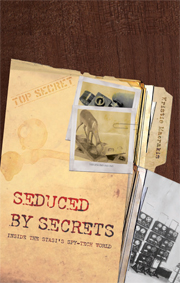Book contents
- Frontmatter
- Contents
- List of Photographs, Charts, and Table
- Abbreviations and Organizations
- Preface
- Acknowledgments
- Introduction
- PART I HIGH-TECH
- 1 Agent Gorbachev
- 2 Stealing Secrets
- 3 Hero, Traitor, Playboy, Spy
- 4 The Crown Jewels
- 5 “Kid” and “Paul”
- 6 The Computer Fiasco
- PART II SPY-TECH
- Note on Archival Sources
- Notes
- Index
6 - The Computer Fiasco
from PART I - HIGH-TECH
Published online by Cambridge University Press: 04 December 2009
- Frontmatter
- Contents
- List of Photographs, Charts, and Table
- Abbreviations and Organizations
- Preface
- Acknowledgments
- Introduction
- PART I HIGH-TECH
- 1 Agent Gorbachev
- 2 Stealing Secrets
- 3 Hero, Traitor, Playboy, Spy
- 4 The Crown Jewels
- 5 “Kid” and “Paul”
- 6 The Computer Fiasco
- PART II SPY-TECH
- Note on Archival Sources
- Notes
- Index
Summary
At 5:10 a.m. on 5 December 1989, Artur Wenzel was found dead in his jail cell at the central East Berlin police station. He had hung himself on the cell window with his leather belt. He was a tidy man who attended to appearances, and his shoes were placed neatly in a corner. He usually wore a businessman's suit and tie and had dyed jet-black, slicked-back hair, which did not match his fair complexion and blue eyes. When police detained the well-dressed, corpulent fifty-five-year-old “businessman” outside of his Alexanderplatz “House of Electronics” office in the heart of the city the day before, they seized two suitcases containing more than half a million West German marks and 100,000 East German marks – more than a quarter of a million dollars.
Was Wenzel planning to flee the country and go underground with this large amount of money or was he merely carrying out a business transaction as he told investigators the next day? No ordinary citizen, and not even a real businessman, Colonel Wenzel had faithfully served the Ministry for State Security for thirty-five years and had been head of internal security's microelectronics unit, where he had worked on countering economic espionage since 1981. It is not surprising that Wenzel had access to large amounts of money, given his position. The Stasi had established good relations with Alexander Schalck-Golodkowski, Secretary of State for Foreign Trade, who provided East Germany with the hard currency it needed for expensive technology.
- Type
- Chapter
- Information
- Seduced by SecretsInside the Stasi's Spy-Tech World, pp. 112 - 140Publisher: Cambridge University PressPrint publication year: 2008

